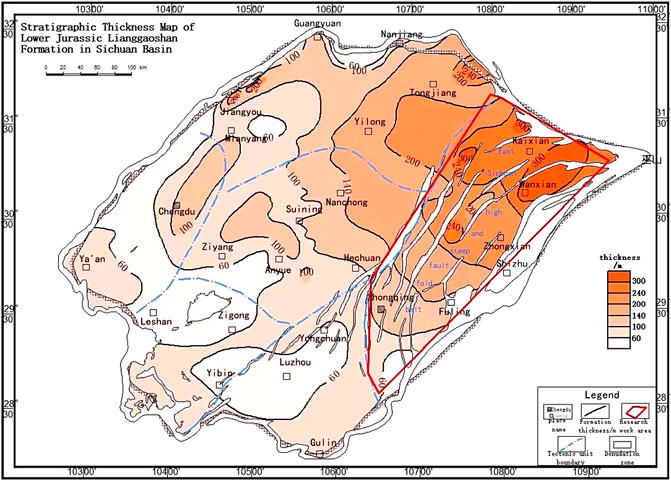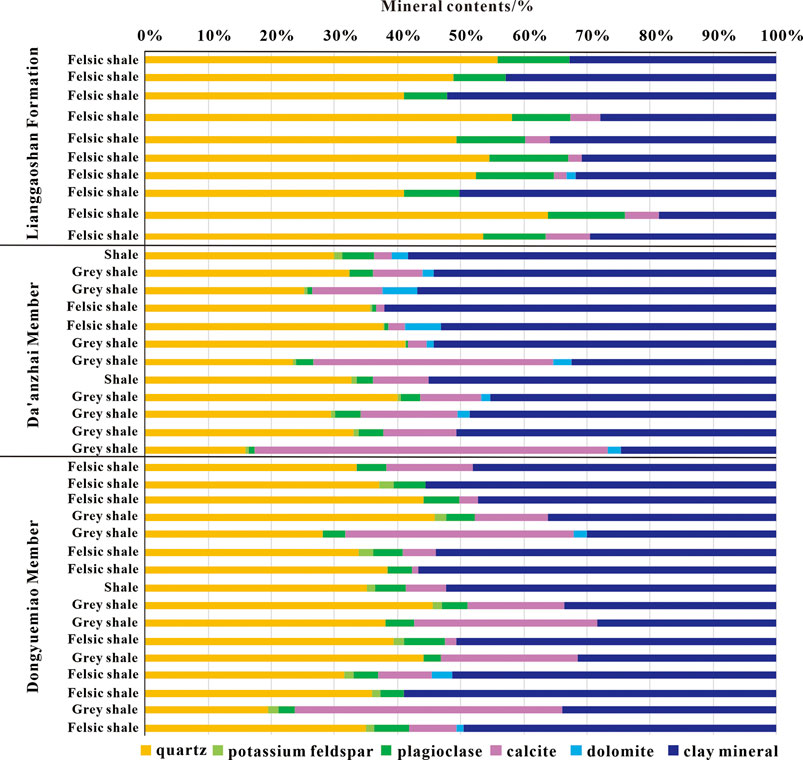- 1Exploration and Development Research Institute of PetroChina Southwest Oil and Gas Field Company, Chengdu, China
- 2Shale Gas Evaluation and Exploitation Key Laboratory of Sichuan Province, Chengdu, China
- 3College of Geosciences, China University of Petroleum Beijing, Beijing, China
- 4Institute of Sedimentary Geology, Chengdu University of Technology, Chengdu, China
- 5PetroChina Research Institute of Petroleum Exploration and Development, Beijing, China
The eastern Sichuan Basin in China holds vast potential for oil and gas exploration in the Lower-Middle Jurassic strata. However, the geological characteristics and hydrocarbon accumulation patterns of this region remain largely unclear. During the deposition period of the Lower-Middle Jurassic strata, the eastern Sichuan is characterized by the formation of multiple sets of source, reservoir, and caprock assemblages through depositing lake-delta-fluvial deposits, which have great exploration potential. The Jurassic source rocks in eastern Sichuan are mainly developed in the Dongyuemiao Member, Da’anzhai Member, and Liangshan Formation. These source rocks have a total organic carbon (TOC) content greater than 1 and a varying range of organic matter maturity, with a Ro value of 0.8–2.0. The kerogen in these source rocks is primarily type II, with a smaller proportion being type III. A range of reservoir rocks can be found in the Jurassic strata of eastern Sichuan, with sandstone reservoirs being predominantly found in the Liangshan Formation, Shaximiao Formation, and Zhenzhuchong Member. Shale reservoirs are mostly present in the Dongyuemiao, Da’anzhai, Liangshan, and Maanshan Members, and there is a limited distribution of limestone reservoirs in the Da’anzhai Member and Dongyuemiao Formation. The arrangement of source rocks and reservoir rocks in eastern Sichuan has led to the formation of three types of reservoir-forming combinations, including lower generation and upper storage, self-generation and self-storage, and composite. Sandstone reservoirs are typically of lower generation and upper storage, shale reservoirs are primarily of self-generation and self-storage, and limestone reservoirs are mostly composite. The exploration of Jurassic oil and gas in eastern Sichuan should prioritize “layer and area selections.” The Da’anzhai, Dongyuemiao, and Liangshan shale reservoirs should be the primary exploration targets, with the semi-deep lake deposits in the syncline area being the most favorable. The degree of fracture development in the exploration area also has a significant impact on the shale oil and gas content. The Liangshan Formation and Shaximiao Formation sandstone reservoirs can serve as secondary exploration targets, with anticline areas that have better sealing conditions being more favorable. Limestone reservoirs have limited distribution, and exploration areas with high and steep fractures are relatively more advantageous.
1 Introduction
Over the past few years, the continued expansion and deepening of oil and gas exploration has resulted in the discovery of oil and gas reservoirs in the Jurassic strata of the Sichuan Basin, such as the Da’anzhai Member, Lianggaoshan Formation, Shaximiao Formation, and others (Chen, 1990; Wang et al., 2012; Xiao et al., 2018; Yang et al., 2019; Wang et al., 2021), indicating a positive outlook for crude oil exploration in the region. Despite this, the exploration and development of oil and gas in the eastern Sichuan Basin has primarily focused on deep marine strata, while continental strata exploration remains relatively underdeveloped, particularly with regard to the Jurassic oil and gas geological characteristics. In the Wanzhou-Fuling area, the sandstone of the Shaximiao Formation and the shale of the Da’anzhai Member have already produced industrial oil and gas after drilling in the Wubaochang area (Wang et al., 2012; Yang et al., 2019). Furthermore, the application of vertical well fracturing in the sandstone of the Lianggaoshan Formation in the old Tiandong 002-X18 well has also produced industrial gas flow. Additionally, Wells Taiye 1 and Fuye 10HF, which were tested in the shale of the Lianggaoshan Formation and the Dongyuemiao Member, respectively (Wang et al., 2018; Hu et al., 2021; Shu et al., 2021), have produced medium-high yield industrial oil and gas, indicating the promising exploration potential of the Jurassic lacustrine strata in the eastern Sichuan Basin. Despite these developments, research into the Jurassic strata in the eastern Sichuan Basin is still relatively limited, and there is a lack of systematic studies on stratigraphic development characteristics, sedimentary systems and evolution, and oil and gas systems. This significantly limits future exploration decisions. Therefore, it is imperative to investigate the oil and gas geological characteristics of the Jurassic in the eastern Sichuan Basin, identify favorable zones and layers, and provide technical support and understanding for oil and gas exploration in the area.
2 Geological setting
The Sichuan Basin underwent foreland basin evolution during the Late Triassic, which was primarily controlled by the differential thrust nappe tectonic activities of surrounding orogenic belts (Guo, 1996; Chen et al., 2019). The period after the Late Triassic was the main period of construction for the current landform and tectonic basin of the Sichuan Basin (Liu et al., 2011; Wang et al., 2022). The late Indosinian movement resulted in varying degrees of erosion of the Upper Triassic Xujiahe Formation (Wu et al., 2013). The Early Jurassic Luzhou-Huayingshan uplift subsided, and the Weiyuan uplift began to form, creating a depression area in western-central and northeastern Sichuan, and an uplift area in southeastern Sichuan (Sun et al., 2012; Xu et al., 2016). The Early Jurassic Zhenzhuchong Member is dominated by vertical progradation sequences of river and lake facies, influenced by the early nappe structure. During the sedimentary period of the Ma’anshan Member, the Songpan-Ganzi Plateau in the western margin of the basin continued to uplift, leading to the formation of coarse-grained braided river-fan delta deposits, while central Sichuan saw extensive shallow lake beach-bar deposits. The Da’anzhai Member was characterized by weak tectonic activity of the basin margin, steady subsidence, and weak source supply, resulting in the largest lake in the Early Jurassic (Li, 2014). During the sedimentary period of the Lianggaoshan Formation, the Micang Mountain-Daba Mountain region in the northern margin of the basin was undergoing intense tectonic activity, which provided a vast number of clastic materials. At the same time, the southeastern margin’s Xuefeng uplift was a stable source of sediment. This resulted in the dominance of a delta-semi-deep lake sedimentary system in the basin (Yang, 2014).
The Late Early Cretaceous period saw the formation of a series of northeast-southwest trending, high-steep structural belts in the eastern Sichuan region as a result of the continuous compression of the Xuefeng-Jiangnan ancient land in the southeast and the Micang-Daba Mountains in the north (Zou et al., 2015). These belts consist of alternating complex anticlines and synclinoriums that form barrier folds (Figure 1). The uplift of the anticline area on a large scale and its subsequent strong denudation processes have made it a favorable site for conventional oil and gas exploration (Yuan et al., 2014). In contrast, the syncline area is more suitable for unconventional oil and gas exploration.
3 Source rock characteristics
The Jurrasic source rocks in eastern Sichuan are primarily found in the Dongyuemiao Member, Da’anzhai Member, and Lianggaoshan Member of the Lower Jurassic Ziliujing Formation. These formations experienced typical lake transgression events during sedimentation, leading to the widespread development of shale and thus the high organic matter content.
Over 70% of the shale samples had a TOC greater than 1%, with more than 10% of the samples measuring TOC greater than 2%. The average TOC of the samples with TOC greater than 1% was 1.70%, which represents the highest organic matter abundance. The organic carbon content of dark shale in the Da’anzhai Member was mainly concentrated in the range of 1%–2%, with 57% of the samples measuring TOC greater than 1%, averaging 1.51%. The distribution of TOC was relatively concentrated, but with a relatively small range of high values. The organic matter abundance of shale in the Lianggaoshan Formation was relatively low, with the average TOC of 1% samples measuring 1.65%. Silty mudstone in the Lianggaoshan Formation had a relatively low TOC content and weak hydrocarbon generation potential. The measured TOC content of mudstone samples from the Zhenzhuchong Member of the Ziliujing Formation and Shaximiao Formation was mostly less than 0.5%, making them non-hydrocarbon source rocks. Although the number of measured samples from the Zhenzhuchong Member and Shaximiao Formation was relatively small, it can be concluded that the organic matter abundance of mudstone in these formations in eastern Sichuan was generally low and did not meet the standards of a source rock based on the characteristics of most cores, which were mainly variegated, purplish red, and gray-green. The high-quality source rocks of the Dongyuemiao Member, Da’anzhai Member, and Lianggaoshan Formation accounted for over 60% of the total, followed by general source rocks. Nonsource rocks were a relatively small proportion, with the nonsource rocks of the Lianggaoshan Formation shale accounting for the highest proportion.
As shown in Figure 3, the areas with high organic matter content (TOC ≥ 1%) in Lower Jurassic source rocks in eastern Sichuan are mainly located in the Kaixian-Liangping-Zhongxian-Fuling region. The organic matter enrichment areas in the three mudstone shale formations are distinct. The Dongyuemiao Member has a high TOC content in the Kaixian-Liangping-Zhongxian area (Figure 2A), with TOC values exceeding 1.3% and a thickness of approximately 15–30 m (Figure 2B). The quality of shale in the Da’anzhai Member is relatively poor in the eastern Sichuan, with high TOC areas mainly located in the Yilong-Quxian-Liangping area and TOC values ranging from 1.2% to 1.6% (Figure 3A). In the central Sichuan area, the semideep-deep lake facies are more developed, leading to an increase in the TOC of the shale (Figure 3B). The Gaoshan Formation shales are developed in the eastern Sichuan Basin, and the source rocks with the highest organic matter content are primarily located in the Kaixian and Liangping areas, with an average TOC of over 1.3% (Figure 3C).

FIGURE 2. TOC distribution characteristics of Jurassic mudstone in the eastern Sichuan Basin: (A) TOC distribution diagram and (B) statistical table of mudstone samples from different layers of the Jurassic in eastern Sichuan.
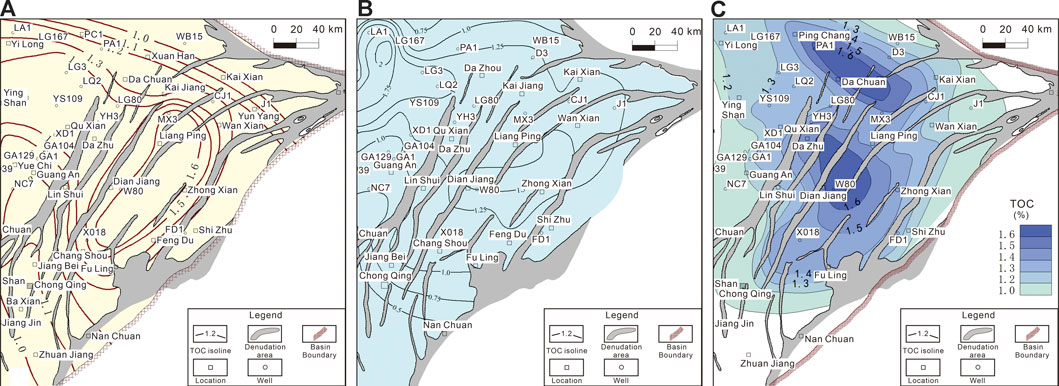
FIGURE 3. TOC contour map of main source rocks of the Lower Jurassic in the eastern Sichuan Basin. (A) Dongyuemiao shale. (B) Da’anzhai shale. (C) Lianggaoshan shale.
Microscopic analysis of kerogen indicates that the organic matter in eastern Sichuan mudstone is dominated by humic amorphous and vitrinite, with very low filamentous content. The kerogen type is mainly type II2, with small amounts of type III and type II1, and type I kerogen is absent (Figure 4). Ro of Lower Jurassic source rocks in eastern Sichuan is between 0.8% and 2%, indicating that the source rocks have reached the hydrocarbon generation threshold and are in the mature to high mature stage. The Dongyuemiao Member has the highest Ro, ranging from 1.2% to 1.6%, and is in the mature to high mature stage, with the main products being condensed gas. The Gaoshan Formation has the lowest Ro, mainly between 0.8% and 1.4%, and is in the peak oil generation to early gas generation stage, with oil generation still being dominant. The Da’anzhai Member has a moderate Ro, ranging from 0.9% to 1.5%, and is in the peak oil-gas generation stage.
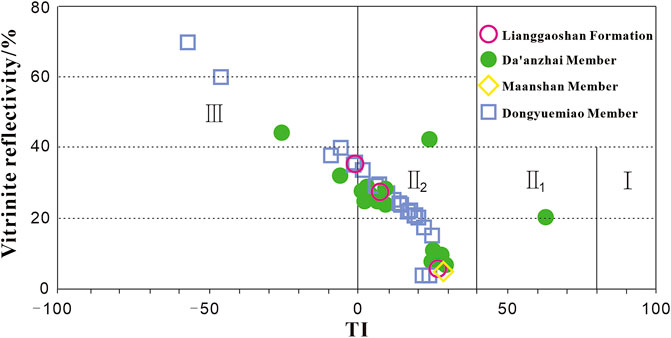
FIGURE 4. Kerogen types of Jurassic source rocks in the eastern Sichuan Basin (partial data from the literature: Deng, 2016)
4 Reservoir characteristics
A variety of reservoir rock types developed in the Jurassic in eastern Sichuan. The Zhenzhuchong Member of the Ziliujing Formation and the Shaximiao Formation are mainly of sandstone reservoirs, while Dongyuemiao Member and Da’anzhai Member are mainly of shale and carbonate reservoirs. The sandstone and shale reservoirs of the Lianggaoshan Formation also exhibit a certain degree of development (Figure 5).
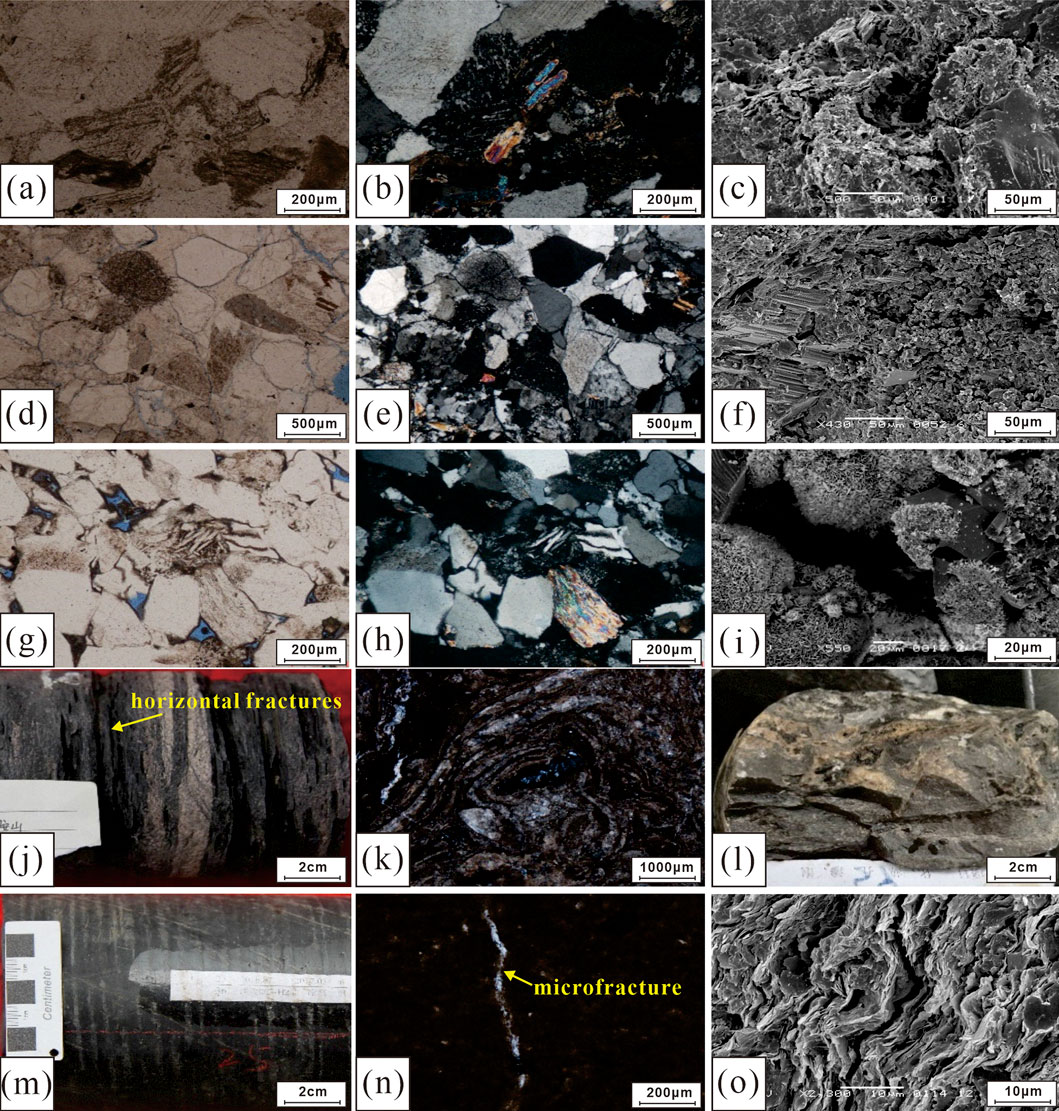
FIGURE 5. Characteristics of the Jurassic reservoir rocks in the eastern Sichuan Basin. (A–C) Medium-grained lithic feldspar sandstone, containing granite, granitic gneiss debris, authigenic kaolinite filling intergranular pores, with a small amount of residual intergranular pores, Well Wubaoqian 20, 3531.21 m, Zhenzhuchong Member. Panel a is the pore-casted thin section (−), panel b is the pore-casted thin section (+), and panel c is the scanning electron microscope photograph. (D–F) Coarse lithic feldspathic sandstone, with granite debris, laumontite filling cemented intergranular pores, sporadic secondary dissolution pores, extremely developed microfractures, Well Wubaoqian 006-H1, 1807.5 m, Shaximiao Formation. Panel d is pore-casted thin section (−), panel e is pore-casted thin section (+), and panel f is scanning electron microscope photograph. (G–I) Medium-grained lithic sandstone, chlorite rim cementation, well-preserved primary intergranular pores, Well Tiandong 021-X8, 1792.4 m, Lianggaoshan Formation. Panel g is pore-casted thin section (−), panel h is pore-casted thin section (+), and panel i is scanning electron microscope photograph. (J) Gray black shell-bearing shale, developed horizontal fractures, filled with calcite veins, Well Yunan 012-X8, 2664.5 m, Da’anzhai Member. (K) The shell layer in mudstone with secondary dissolved pores and filled with asphalt, Well Yunan 012-X8, 2465.22 m, Da’anzhai Member. (L) Bioclastic limestone, development of high-angle fractures, along the fracture development of dissolved pores and caves, filling asphalt, 750.13 m, Da’anzhai Member. (M) Gray black mudstone, Well Yangdu 003-H2, 2017 m, Lianggaoshan Formation. (N, O) Gray mudstone, developed bedding fracture, 2017.77 m, Lianggaoshan Formation.
4.1 Sandstone reservoirs
In eastern Sichuan, the Zhenzhuchong Member, Lianggaoshan Member, and Shaximiao Member of the Ziliujing Formation display different degrees of sandstone development. However, the characteristics of the sandstone reservoirs vary greatly in different strata. The Zhenzhuchong Member has relatively dense sandstone reservoirs, with fewer effective pores (Figures 5A, B) observed in the pore-casted thin sections (Figures 5A, B), and no obvious apparent pores are found. SEM analysis reveals that there is a small amount of residual intergranular pores filled with authigenic kaolinite (Figure 5C), which mainly consist of micropores. The Shaximiao Formation sandstone has a high content of cements such as laumontite and calcite (Figures 5D, E). The type of intergranular pore reservoir space mainly consists of microcracks (Figure 5D), with a small amount of residual intergranular pores (Figure 5F) and feldspar dissolution pores. The sandstone of the Gaoshan Formation has an obvious early chlorite rim cementation, which has a significant inhibitory effect on compaction and cementation. The primary intergranular pores in this kind of reservoir are well preserved (Figures 5G–I), resulting in high porosity.
4.2 Shale reservoirs
Shale reservoirs are most developed in the Da’anzhai Member, Dongyuemiao Member, and Lianggaoshan Formation. X-ray diffraction analysis shows that the Jurassic shale in eastern Sichuan is dominated by clay minerals, and the quartz content is generally high. Among them, the quartz contents of the Dongyuemiao Member and Lianggaoshan Formation are relatively high, and the quartz content of the Da’anzhai Member is slightly lower. The contents of carbonate minerals such as calcite and siderite are high, and the Dongyuemiao Member and Da’anzhai Member have the highest contents. The feldspar content is 3.5%–14.1%, with no significant differences between layers (Figure 6). The content of Jurassic felsic brittle minerals in eastern Sichuan is generally between 30% and 60%, which is lower than that in typical marine shale (Wang et al., 2015).
Certain shell layers are developed in the Da’anzhai Member and the Dongyuemiao Member shale. The thickness of the shell layer varies from 0.2 cm to 10 cm, forming a thin layer of shale with the shell layer or the combination of the shell layer and the shale layer. A large number of horizontal fractures are developed, and some of the fractures are filled with calcite veins (Figure 5J). Under the microscope, secondary dissolved pores are developed in the common shell layer and calcite veins, and asphalt is partially filled (Figure 5K). Additionally, the scanning electron microscope reveals numerous intergranular pores and clay mineral intergranular pores, with few organic pores. The dark shale in the Gaoshan Formation displays well-developed horizontal bedding (as seen in Figure 5M), and is often interspersed with silty thin layers and occasional shell layers. Pore-casted thin sections and scanning electron microscopy analysis indicate the presence of microfractures (Figure 5N, Figure 3). The matrix pores are dominated by inorganic pores such as residual intergranular pores, dissolution pores, and clay mineral intercrystal pores.
4.3 Limestone reservoirs
Bioclastic limestone and shell limestone are the main forms of reservoirs. The calcareous cementation of such rocks is generally strong, and dissolution is only in areas with high-angle fracture development (Figure 5L). The reservoir space primarily consists of cracks and secondary dissolution pores, and the limestone with undeveloped cracks is dense.
5 Hydrocarbon accumulation characteristics
Three sets of Lower Jurassic source rocks are developed in the eastern Sichuan Basin, which are matched with different types of reservoir rocks to form various types of reservoir-forming assemblages, including lower generation and upper storage type, self-generation and self-storage type, and composite type.
5.1 Lower generation and upper storage reservoir-forming assemblage
In this type of reservoir-forming assemblage, the source rock is located in the lower part, while the reservoir is directly on the source rock or separated from the source rock. Oil and gas migrate upward through faults and fractures, filling the sand body to form oil and gas reservoirs (Fusen and Tinghu, 2007; Kong et al., 2021). This type of reservoir-forming assemblage is common in the upper part of the Shaximiao Formation and Lianggaoshan Formation in eastern Sichuan, forming lithologic and lithologic-structural reservoirs (Xu et al., 2021). This type of reservoir-forming assemblage is mainly formed in sedimentary facies such as underwater distributary channels and beach bar sand in delta fronts. Due to the development of high and steep structures in eastern Sichuan, the Shaximiao Formation and Lianggaoshan Formation have different degrees of denudation. At the same time, the synclinal area has less denudation but more developed faults. Therefore, the quality of caprock and preservation conditions is the key to determining whether such reservoirs are destroyed.
5.2 Self-generation and self-storage reservoir-forming assemblage
The mud shales of the Dongyuemiao Member, Da’anzhai Member, and Lianggaoshan Formation serve as both source rocks and oil and gas reservoirs, which have the characteristics of source-reservoir homogeneity. The discovered Fuling Gas Field and Jiannan Gas Field belong to this type of reservoir combination (Zhou et al., 2012; Zhou et al., 2013). Shale oil and gas exploration practices show that the main occurrence location of these reservoirs is in syncline areas. The distribution of shale oil and gas is largely influenced by factors such as the abundance, type, and maturity of organic matter. To achieve industrial production, oil and gas reservoirs often require fracturing and other technical means, making the type and content of brittle minerals critical factors. The brittle minerals in the Da’anzhai and Dongyuemiao Members are primarily composed of quartz and feldspar, with calcite present mainly in the form of shells, followed by cement. However, the influence of calcite on brittleness is still unclear and different from that of marine shale. Additionally, the development of fractures plays a significant role in enhancing the enrichment and availability of shale oil and gas.
5.3 Composite reservoir-forming assemblage
Most limestone reservoirs belong to this type of reservoir-forming assemblage, where high-angle fractures connect to the lower source rocks. This allows for oil and gas to enter the limestone reservoirs from the upper and lower Xujiahe Formation, and even deeper marine strata, through fractures. Adjacent mud shales also have the potential to supply hydrocarbons to the limestone reservoirs. The source of oil and gas in these cases can be complex and classified as a composite accumulation combination. Such oil and gas reservoirs are typically dense and have locally developed dissolution pores. In addition to having necessary conditions, such as hydrocarbon sources and reservoirs, it is also important to have a certain level of fracture development to increase reservoir connectivity and create effective channels for oil and gas migration. However, it should be noted that based on current research, the development of these reservoirs in the Jurassic of the eastern Sichuan is relatively limited and only found in the Da’anzhai Member and Dongyuemiao Member limestones in Wells W081-H1 and Yuntan 1.
6 Exploration direction
The complexity of the Jurassic source-reservoir-cap assemblage and oil and gas reservoir types in eastern Sichuan requires different exploration approaches for different hydrocarbon accumulation configurations. The reconstruction of the sedimentary environment, source rocks, reservoir conditions, structural features, and trap development should be emphasized differently.
(1) Sandstone reservoirs: The Lianggaoshan Formation and Shaximiao Formation should be the primary target layers. The exploration area selection should take into account the development of source rocks in the Dongyuemiao Member, Da’anzhai Member, and Lianggaoshan Formation. Structural-lithologic traps should be the preferred option for exploration, but the caprock development and trap preservation conditions should also be considered in the selection process.
(2) Shale oil and gas reservoirs: The Da’anzhai Member, Dongyuemiao Member, and Lianggaoshan Formation should be the primary exploration targets. The evaluation of the hydrocarbon generation conditions of these strata is crucial, as shale oil and gas reservoirs are mainly of self-generation and self-storage. Research should also focus on the development of fractures, especially horizontal fractures. The exploration mode for continental shale oil and gas, such as the Da’anzhai Member and Dongyuemiao Member, cannot be replicated from that of marine shale gas. The evaluation of continental shale oil and gas should pay more attention to the reconstruction of sedimentary microfacies and sedimentary water properties. The syncline area is still a relatively favorable location for shale oil and gas.
(3) Core observations and drilling in eastern Sichuan have shown that the fracture development degree has a significant impact on the distribution of Jurassic oil and gas reservoirs, particularly shale oil and gas. High-angle fractures are well developed in the Da’anzhai Member and Dongyuemiao Member of Wells Qiuwo 081-H1 and Yuntan 1. Shell limestone and bioclastic limestone with developed fractures have significant dissolution and asphalt filling. Almost all of the observed core gas outbursts in Well Yuntan 1 are located in high-angle fractures, indicating that the degree of fracture development, especially high-angle fractures, may be an important factor affecting the productivity of oil and gas in shale and limestone reservoirs.
Data availability statement
The original contributions presented in the study are included in the article/Supplementary Material, further inquiries can be directed to the corresponding authors.
Author contributions
RB and SZ: Conceptualization, Methodology, Writing-Original Draft. HH: Data curation, Supervision. CQ and YL: Supervision. CC and XK: Formal analysis. NL and DL: Investigation. XL and CW: Validation. TJ and JG: Resources. WT: Software.
Conflict of interest
Authors RB, SZ, HH, CQ, YL, CC, NL, and TJ were employed by PetroChina Southwest Oil and Gas Field Company.
Author JG was employed by PetroChina Research Institute of Petroleum Exploration and Development.
The remaining authors declare that the research was conducted in the absence of any commercial or financial relationships that could be construed as a potential conflict of interest.
Publisher’s note
All claims expressed in this article are solely those of the authors and do not necessarily represent those of their affiliated organizations, or those of the publisher, the editors and the reviewers. Any product that may be evaluated in this article, or claim that may be made by its manufacturer, is not guaranteed or endorsed by the publisher.
References
Chen, Z., Li, W., Wang, Lining, Lei, Y., Yang, G., Zhang, B., et al. (2019). Structural geology and favorable exploration prospect belts in northwestern Sichuan Basin, SW China. Petroleum Explor. Dev. 46 (2), 413–425. doi:10.1016/s1876-3804(19)60022-4
Deng, Y. (2016). Study on shale gas enrichment law in Da’anzhai member of Lower Jurassic in eastern Sichuan. Chengdu, China: Chengdu University of Technology.
Fusen, X., and Tinghu, M. (2007). Exploration and development of Shaximiao formation gas reservoir in Wubaochan structure, Northeast Sichuan. Nat. Gas. Ind. 163 (05), 4–7.
Guo, Z., Deng, K., and Han, Y. (1996). Formation and evolution of Sichuan Basin. Beijing, China: Geological Publishing House.
Hu, D. F., Zhihong, W., and Ruobing, L. (2021). Major breakthrough of shale oil and gas in well taiye 1 in bashansi syncline in the sichuan basin and its significance. China pet. Explor. 21.
Kong, X., Zeng, J., Tan, X., Ding, K., Luo, Q., Wang, Q., et al. (2021). Natural tectonic fractures and their formation stages in tight reservoirs of Permian Lucaogou Formation, Jimsar Sag, southern Junggar Basin, NW China. Mar. Petroleum Geol. 133, 105269. doi:10.1016/j.marpetgeo.2021.105269
Li, Y., and He, D. (2014). Evolution of tectonic-depositional environment and prototype basins of the Early Jurassic in Sichuan Basin and adjacent areas. Acta Pet. Sin. 35 (2), 219–232.
Liu, S., Deng, B., and Li, Z. (2011). Basin mountain structure and oil and gas distribution - a case study of Sichuan Basin. Acta Petrol. Sin. 27 (03), 621–635.
Shu, Z., Zhou, L., Li, X., Liu, H., Zeng, Y., Xie, H., et al. (2021). Geological characteristics of gas condensate reservoirs and their exploration and development prospect in the Jurassic continental shale of the Dongyuemiao Member of Ziliujing Formation, Fuxing area, eastern Sichuan Basin. Oil Gas Geol. 42 (1), 212–223.
Sun, W., Liu, S., and Han, K. (2012). Yanshanian paleotectonic development and its influence on oil and gas in Sichuan Basin. J. Chengdu Univ. Technol. Nat. Sci. Ed. 39 (01), 70–75.
Wang, R., Hu, Z., and Liu, J. (2018). Comparative analysis of characteristics and controlling factors of fractures in marine and continental shales: A case study of the lower cambrian in cengong area,northern guizhou province. Oil Gas Geol. 39.
Wang, R., Hu, Z., and Long, S. (2022). Reservoir characteristics and evolution mechanisms of the upper ordovician wufeng-lower silurian longmaxi shale,Sichuan Basin. Oil Gas Geol. 43 (02), 353–364.
Wang, R., Hu, Z., and Zhou, T. (2021). Characteristics of fractures and their significance for reservoirs in Wufeng-Longmaxi shale,Sichuan Basin and its periphery. Oil Gas Geol. 42 (06), 1295–1306.
Wang, S., Hu, S., and Dong, D. (2012). Jurassic in eastern Sichuan - a new tight oil and gas field in Sichuan Basin. Nat. Gas. Ind. 32 (12), 22–29+125.
Wang, S., Dong, D., Wang, Y., Li, X., Huang, J., and Guan, Q. (2015). Comparative study on geological characteristics of marine shale gas between China and the United States. Nat. Gas. Geosci. 26 (09), 1666–1678.
Wu, Y., Zhang, T., and Tao, S. (2013). Sequence stratigraphic analysis of sedimentary sand bodies in deep-water Lake Basin - a case study of Jurassic in Sichuan. Acta Sedimentol. Sin. 31 (05), 798–806.
Xiao, J., and Xiangfeng, W. (2018). Difference of accumulation conditions between Fuling marine shale gas and Yuanba-Xinglongchang lacustrine shale gas. Nat. Gas Explor. Dev. 41 (04), 8–17.
Xu, A., Hu, S., Wang, Z., Bo, D., Li, M., Lu, W., et al. (2016). Sedimentary mode and reservoir distribution of the Cambrian carbonate & evaporate paragenesis system in the Sichuan Basin. Nat. Gas. Ind. B 3 (5), 418–427. doi:10.1016/j.ngib.2017.02.003
Xu, Y., Dai, Z., Hu, X., Xu, Z., and Dan, L. I. (2021). Geochemical characteristics and geological significance of Shaximiao Formation in northeastern Sichuan Basin: A case study from Wubaochang area. Lithol. Reserv. 33 (01), 209–219.
Yang, s. (2014). Sedimentary evolution and facies controlled reservoir prediction of Jurassic in Sichuan Basin. Chengdu, China: Chengdu University of Technology.
Yang, Y., and Huang, D. (2019). Geological characteristics and new understandings of exploration and development of Jurassic lacustrine shale oil and gas in the Sichuan Basin. Nat. Gas. Ind. 39 (6), 22–33.
Yang, Y., Huang, D., Yang, G., Li, Y., Dai, H., and Rong, B. (2019). Geological conditions to form lacustrine facies shale oil and gas of Jurassic Daanzhai Member in Sichuan Basin and exploration directions. Nat. Gas Explor. Dev. 42 (02), 1–12.
Yuan, Y., Lin, J., and Cheng, X. (2014). Late yanshanian himalayan denudation in western hubei and eastern chongqing. Chin. J. Geophys. 57 (09), 2878–2884.
Zhou, D., and Jiao, F. (2012). Evaluation and prediction of shale gas sweet spots: A case study in jurassic of jiannan area, Sichuan Basin. PETROLEUM Geol. Exp. 34 (2).
Zhou, D., Jiao, F., Guo, X., Guo, D., and Zhihong, W. (2013). Geological characteristics of lower jurassic shale oil and gas in fuling area, southeast sichuan. Oil Gas Geol. 34 (04), 450–454.
Keywords: continental shale, exploration potential, jurassic, eastern sichuan, sichuan basin
Citation: Bai R, Zhang S, Hong H, Qin C, Li Y, Cai C, Kong X, Li N, Lei D, Lei X, Wang C, Jin T, Gao J and Tang W (2023) Source-reservoir rock assemblages and hydrocarbon accumulation models in the Middle-Lower Jurassic of eastern Sichuan Basin, China. Front. Earth Sci. 11:1207994. doi: 10.3389/feart.2023.1207994
Received: 18 April 2023; Accepted: 31 May 2023;
Published: 10 August 2023.
Edited by:
Ruyue Wang, SINOPEC Petroleum Exploration and Production Research Institute, ChinaReviewed by:
Kun Zhang, Southwest Petroleum University, ChinaKuizhou Li, Chengdu University of Technology, China
Copyright © 2023 Bai, Zhang, Hong, Qin, Li, Cai, Kong, Li, Lei, Lei, Wang, Jin, Gao and Tang. This is an open-access article distributed under the terms of the Creative Commons Attribution License (CC BY). The use, distribution or reproduction in other forums is permitted, provided the original author(s) and the copyright owner(s) are credited and that the original publication in this journal is cited, in accordance with accepted academic practice. No use, distribution or reproduction is permitted which does not comply with these terms.
*Correspondence: Shaomin Zhang, zhangsm19@petrochina.com.cn; Xiangye Kong, kongxiangyecup@163.com; Jinliang Gao, jinliang0205@126.com
 Rong Bai1
Rong Bai1